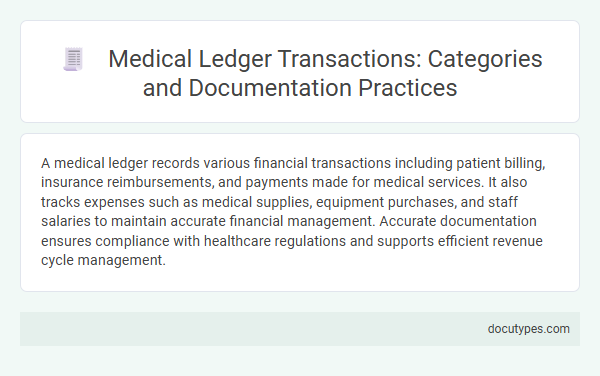A medical ledger records various financial transactions including patient billing, insurance reimbursements, and payments made for medical services. It also tracks expenses such as medical supplies, equipment purchases, and staff salaries to maintain accurate financial management. Accurate documentation ensures compliance with healthcare regulations and supports efficient revenue cycle management.
Introduction to Medical Ledger Transactions
A medical ledger records all financial transactions related to healthcare services and patient accounts. It tracks payments, charges, and adjustments to ensure accurate billing and financial management.
Your medical ledger includes transactions such as patient payments, insurance reimbursements, and billing charges for treatments or consultations. It also records adjustments like refunds, write-offs, and payment plan installments. Maintaining a detailed ledger helps manage the financial health of a medical practice efficiently.
Importance of Accurate Medical Financial Records
Medical ledgers record various types of financial transactions including patient billing, insurance claims, payments received, and adjustments. Accurate documentation of these transactions ensures transparency and accountability in healthcare financial management.
Maintaining precise medical financial records helps prevent errors in billing and facilitates timely reimbursements from insurance providers. You rely on these accurate records to manage budgets effectively and support compliance with regulatory requirements.
Key Categories of Medical Ledger Transactions
| Key Categories of Medical Ledger Transactions | Description |
|---|---|
| Patient Billing | Records charges for medical services, including consultations, treatments, diagnostic tests, and procedures rendered to patients. |
| Insurance Claims | Captures transactions related to submitted claims, reimbursements, denials, and adjustments reflecting insurance payments. |
| Payments Received | Documents payments from patients and insurance providers, including co-pays, deductibles, and full settlements. |
| Adjustments and Write-offs | Accounts for corrected charges, discounts, charity care, or uncollectible amounts removed from patient balances. |
| Expense Tracking | Includes costs related to medical supplies, staff salaries, equipment maintenance, and facility overheads that support healthcare delivery. |
| Revenue Recognition | Reflects recognized revenue earned from medical services during the accounting period. |
| Accounts Receivable | Tracks outstanding payments due from patients and insurance companies for billed medical services. |
Patient Billing and Invoicing Entries
Medical ledgers track various financial transactions critical to healthcare facility operations. Patient billing and invoicing entries represent a core component of these financial records.
- Patient Charges - Lists all services, treatments, and procedures billed to the patient during their medical visit.
- Payment Records - Documents payments received from patients or insurance companies against billed amounts.
- Adjustments and Write-offs - Reflects discounts, insurance adjustments, or uncollectible amounts deducted from the patient's total balance.
Accurate patient billing and invoicing entries ensure proper financial management and compliance within medical practices.
Insurance Claims and Remittance Documentation
A medical ledger records various financial transactions related to patient care, with insurance claims forming a significant portion. These claims document the services provided and request payment from insurance companies, ensuring accurate billing and reimbursement. Remittance documentation details the payments received, adjustments, or denials from insurers, helping you track and reconcile outstanding balances efficiently.
Recording Payments and Adjustments
What types of transactions are recorded in a medical ledger related to payments and adjustments? Medical ledgers document all payments received from patients and insurance companies to maintain accurate financial records. Adjustments such as write-offs, refunds, or corrections are also recorded to ensure your financial data reflects true balances.
Handling Refunds and Patient Credits
A medical ledger records various financial transactions, including patient payments, insurance reimbursements, refunds, and credits. These entries ensure accurate tracking of all monetary exchanges related to medical services.
Handling refunds and patient credits requires precise documentation to maintain financial integrity and patient trust. Your medical ledger should clearly reflect any refunds issued due to overpayments or cancellations and credit balances available for future services.
Best Practices for Ledger Documentation
A medical ledger records a variety of financial and administrative transactions related to patient care and healthcare operations. Proper documentation ensures accuracy, compliance, and transparency in medical accounting.
- Patient Billing Entries - These include charges for services, treatments, and medications provided during patient visits.
- Insurance Claims and Payments - Records of claims submitted to insurers and payments received are documented for reconciliation and auditing purposes.
- Operational Expenses - Expenses such as medical supplies, staff salaries, and facility maintenance are tracked to manage the healthcare facility's budget.
Compliance and Auditing Requirements
Medical ledgers record financial transactions such as patient billing, insurance claim payments, and reimbursements. These entries ensure compliance with healthcare regulations like HIPAA and the Affordable Care Act by maintaining accurate and transparent financial documentation. Auditing requirements mandate that all transactions are traceable and verifiable to prevent fraud and support regulatory reviews.
What Types of Transactions Are Recorded in a Medical Ledger? Infographic

